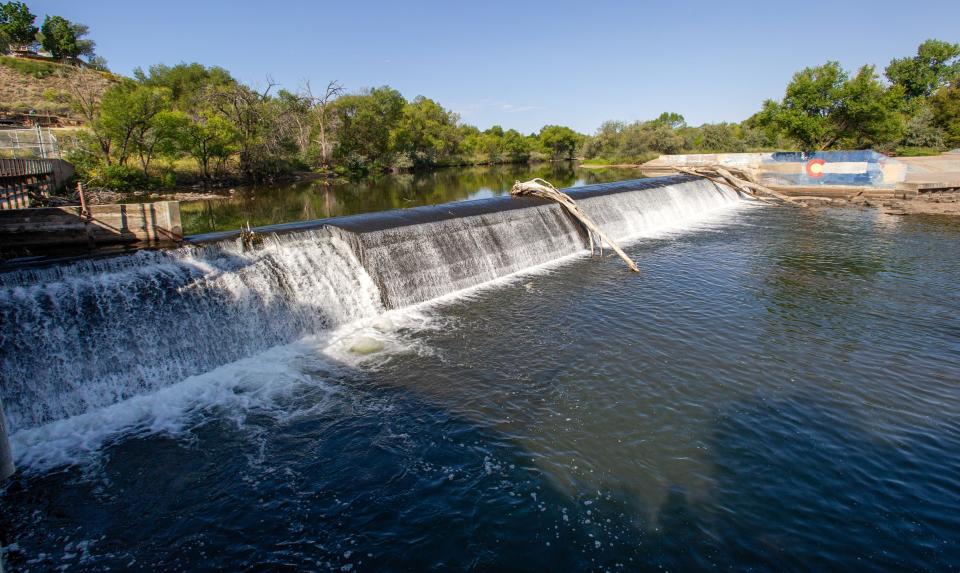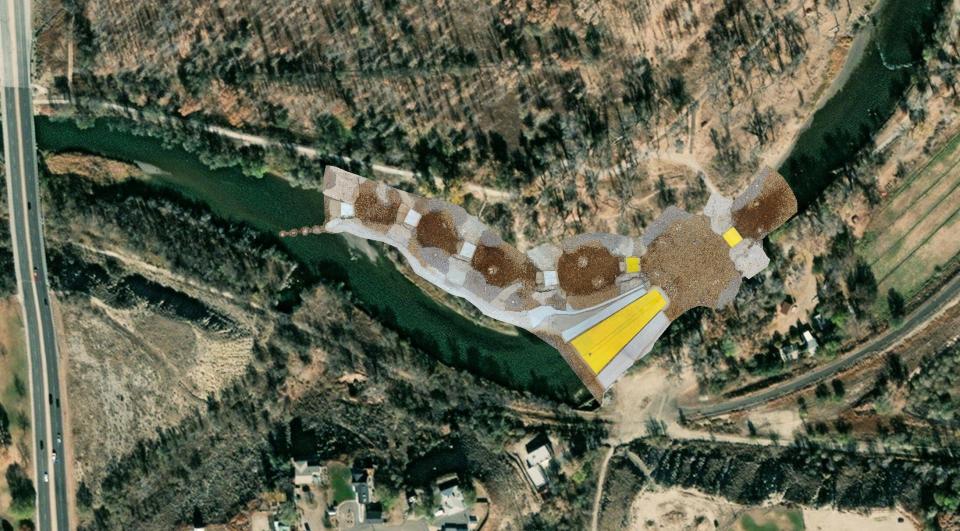Here's an early look at Pueblo Water's reconstruction plans for the Southside dam

Pueblo Water expects to begin reconstruction of the Southside Diversion Dam and Raw Water Intake facility behind City Park in early September, it announced Tuesday during a project update at the Rawlings Library.
Reconstruction is expected to last around eight months before Pueblo Water begins a full commissioning of the rehabilitation project, which it announced in 2021 to improve safety on that part of the Arkansas River and “create a passageway that would allow users to ride the river unimpeded.”
That commissioning is estimated to start in July 2024, with accessibility of the area to come after that’s completed.
“The design is such that you can float down through that boat passage in an inner tube and be fairly sure that you’re not going to run into an issue,” said Seth Clayton, executive director of Pueblo Water. “That creates additional recreational opportunities. Right now, we have that reach of the river split into two with that low-head dam, so this will open things up and make that reach of the river from below Pueblo Reservoir all the way to Runyon Lake fully navigable.”
The estimated cost of the project is $11 million. To cover that, Pueblo Water secured a $9.75 million low-interest loan from the Colorado Water Conservation Board and the city, county and Pueblo Conservancy District each pitched in $325,000. Pueblo Water will cover the rest, Clayton said.
Clayton also said Pueblo Water is unlikely to change its rates to help repay the loan.
Why is Pueblo Water rehabilitating the dam?
The dam, at times, has been a hazard for people who visit that area by water or land. In summer 2020, a father and son, Ricardo Valencia Sanchez, 46, and Jose Louis Valencia, 16, drowned after they were ejected from a raft on that stretch of the Arkansas River. Pueblo Water said these deaths accelerated the timeline of the project, which it had started design work for at the end of 2018, Clayton said.
Because of that hazard, Pueblo Water called the safety of the community a “primary driver” for the project.
“This existing dam has about a 12-foot drop from upstream to downstream,” said Scot Burbidge, transmission, distribution and engineering manager for Pueblo Water. “What happens during different and higher flow conditions is the water is so efficiently passed to the downstream side, it creates a high velocity current that moves water with quite a force back toward the dam. Anybody that comes over the dam gets caught in that current.”

Burbidge added that even the strongest of swimmers could have great difficulty in swimming out of that situation because of the strength of the moving water.
What does the design look like?
There are a lot of parts to the design, but in addition to enhancing the safety of the area and incorporating a recreational element, the design includes small channels for fish to safely swim downstream through that area and maintains some of the dam’s key functions, including the ability to divert water to the Riverside Dairy Ditch, among others.
More: Summer paving season has arrived. Here's what to know about this year's projects
To make the area safe to navigate, a series of six drops, or pools, will be created along the north side of the river. Those will fall incrementally at a total of 12 feet, Burbidge said.
At their deepest points, each of those pools will be about 3 to 4 feet, said Joe Cervi, public relations specialist for Pueblo Water. They’ll also feature a calm stream with “beaches” alongside them if people want to temporarily exit the water.
A chute spillway will be built where the 12-foot drop is now and should provide a “safer and less dangerous” path downstream if people decide to take that route, which would operate like a lazy river, Clayton said.
Pueblo Water constructed a model to simulate the flow of water through this design.
“It makes sure we don’t create any different conditions upstream or downstream by the new construction,” Burbidge said.
Contractors will construct a new pedestrian bridge that will tie into a new trail system, which at certain points will connect to the existing one near the north end of the river. The existing pedestrian bridge in that area will be relocated upstream near Pool 3 and should provide access from the trail to people who want to recreate or fish in the area.

Clayton said the project could potentially lead to other opportunities in the future such as the erection of a parking lot near Pueblo Boulevard, allowing people to walk to the area from their cars, or tying it in with the Nature and Wildlife Discovery Center’s River Campus.
“I think it’s going to be a really tremendous project and amenity for a lot of people,” Clayton said.
Some residents who live around the area express concerns
At Tuesday's project update, some attendees who live near the dam and project site cited infrastructure and stormwater concerns with the surrounding area. Others questioned what the impact will be on nearby residents with what’s expected to be increased foot traffic in that area because of its recreational potential.
Clayton was amenable to those concerns but said they are unlikely to alter the project in any way because they are “exclusive” of one another and the project. Pueblo Water owns the dam but none of the surrounding property.
However, he said Pueblo Water has worked with the city regarding the planned trail system and new pedestrian bridge and that it’s open to joining, if need be, any community sessions that include those residents and the city.
City Council President Heather Graham and councilor Larry Atencio each urged residents who might be impacted by the project to meet and discuss concerns so they can address them with the city.
Chieftain reporter Josue Perez can be reached at JHPerez@gannett.com. Follow him on Twitter @josuepwrites.
This article originally appeared on The Pueblo Chieftain: What we know about reconstruction plans for Pueblo's Southside dam

 money
money 